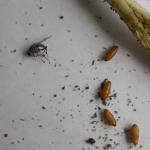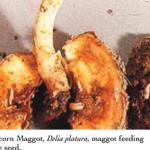Seed Corn Maggot
Delia platura
Seedcorn maggot larvae feed on the seeds and young seedlings of a wide variety of vegetable crops. The first plantings of large-seeded crops such as corn, beans, and peas are often attacked, as well as early seedlings of spinach, onions, brassicas, tomato, cucurbits, and others.
Identification:
Seedcorn maggot flies are nearly identical to cabbage and onion maggot flies - delicate, hump-backed, brown flies, 5-7mm long - but are distinguishable by the fact that each fly will only appear near its host crop. Maggots can usually be found in the soil around and inside seedlings and seeds. The larvae, or maggots, are about ¼ inch long, yellowish-white and legless, with a pointed head. The adults look like small, delicate houseflies with a slightly humpbacked shape.
Life Cycle:
Eggs are laid on the soil surface near sprouting or decaying seeds, organic plant residue, or organic soil amendments such as manure or seed meals. In early spring, the adults emerge and lay eggs on the soil surface. They are attracted to volatiles released from freshly tilled soil, as well as to buried cover crop residues, rotting manure, compost, organic surface residues (as is found in reduced till), and other organic amendments such as fish, soybean or cottonseed meal. Previously injured or diseased plants may also attract egg-laying. The eggs hatch within 2-4 days at soil temperatures of 60°F, and 7-9 days at 41-45°F. Maggots burrow downward in search of food and penetrate seeds as the seed coat splits open.
One reason for the early activity of maggot flies is their ability to develop at a lower threshold, or base temperature, compared to many other insects—39°F (4C) instead of the usual 50-55°F (10-13°C). Like other insects, they develop faster at higher temperatures, with optimal growth around 70°F (21°C). Emergence can be estimated using cumulative growing degree days, starting January 1st. Degree days can be calculated on a daily basis by using the formula: [(Max temp – Min temp)/2 ] – base temperature. To use GDD accurately, it is important to keep track of whether you are in Farenheit or Celsius, and to use a base temperature suited to the insect (or plant) of interest. Scientists have determined the accumulated GDD required for seedcorn maggot to reach peak adult emergence for first, second and third generation flies. This model is based on GDD accumulated since January 1st at base 40°F/4°C.
| Peak Flight | Seed Corn | Onion | Cabbage |
| 1st gen | 360 | 735 | 452 |
| 2nd gen | 1080 | 1752 | 1261 |
| 3rd gen | 1800 | 2975 | 2176 |
| 4th gen | - | - | 3014 |
The second and third generation peaks may be variable for a number of reasons, including the ability of larvae to enter dormancy when it gets too hot. Thus it may not be easy to track the successive generations, but it is the first generation that causes the most damage. Crops that are planted in wet soil, or soil that is too cool to support quick germination and seedling growth, are especially susceptible to damage. Seedlings are sometimes able compensate and recover from seedcorn maggot injury, depending on: the number of larvae per plant, the crop (eg. cantelope is less able to recover than bean or corn), seedling size, and growth conditions. Conditions that favor crop emergence and growth help seeds and seedlings escape or recover from injury.
Crop Injury:
Seed corn maggot attacks seeds - especially large seeds like corn, beans and peas – as well as seedlings of a wide variety of plants. Decay from soil pathogens or previous insect feeding makes seeds or seedlings more attractive to seedcorn maggot. Moist, freshly turned soil is preferred over dry or saturated soil. Damage may be to the seed itself or to roots, stems or cotyledons.
The first symptoms are usually poor germination or wilting of transplants that have lost their roots to feeding larvae. Symptoms can be difficult to distinguish from other problems, such as damping off due to Pythium and other soilborne fungi, or wireworm feeding. Symptoms may also be similar to damage caused by the cabbage or onion maggot, but seedcorn maggot becomes active two or more weeks earlier in the spring than do the other maggot flies. Prevention is key in managing this pest. By the time you see damage, it is too late to control the problem using either cultural or chemical methods.
Biological Controls:
Unfortunately, practices that enhance organic matter in the soil may actually worsen seedcorn maggot problems. For example, one field where seedcorn maggot caused significant damage to early peas had been rotated through two years of rye cover crop to build organic matter. Another instance occurred after a thick winter cover of vetch and rye. Conditions that cause slow seed emergence (cold, wet soils) favor seedcorn damage, while those that favor faster crop growth (warmer soils, moderate moisture) help the crop get established before damage occurs. Where possible, delay planting for several weeks after a cover crop is incorporated to help reduce seedcorn maggot problems.
Cultural Controls:
- Avoid seeding fields (especially wet fields) too early. Seeds germinate more quickly and are less vulnerable in warmer soils. Be patient! Check soil temperatures and use forecasts to determine likely soil conditions for emergence.
- Disk and incorporate organic matter (such as a cover crop) at least 4 weeks before seeding to give it time to break down and make the field less attractive to the flies for egg-laying.
- Avoid applying manure or unfinished compost in late fall or early spring to heavy soils that you might want to plant early. Lighter, well-drained, sandy soils are less likely to have problems (because they warm up faster than others).
- Row covers can help – but only if the maggot flies are coming from elsewhere. Damage can occur if the flies have overwintered in the soil and thus end up underneath the row covers. Avoid covering seedlings that were planted into recently incorporated, lush cover crops.
- If you need to replant, wait at least 5 days if maggots that you find are a quarter inch long; if they are smaller than that, wait at least 10 days to make sure they have pupated and will not damage the new seeds.
- Preventive chemical treatments include commercially applied seed treatments (such as thiamethoxam) and in-furrow applications of pyrethroid, carbamate or organophosphate insecticides. For details, see crop/insect sections of the New England Vegetable Management Guide for corn, beans or other crops.
For current information on production methods (including varieties, spacing, seeding, and fertility), weed, disease, and insect management, please visit the New England Vegetable Management Guide website.
Crops that are affected by this insect:
Adapted from and with thanks to the following sources: E. Sidemann, Technical Advisor, Maine Organic Farmers and Gardeners Association; Ellen Cullen, University of Wisconsin Extension Entomologist; J. Capinera, Handbook of Vegetable Pests.
The Center for Agriculture, Food and the Environment and UMass Extension are equal opportunity providers and employers, United States Department of Agriculture cooperating. Contact your local Extension office for information on disability accommodations. Contact the State Center Director’s Office if you have concerns related to discrimination, 413-545-4800 or see ag.umass.edu/civil-rights-information.

